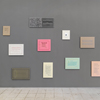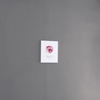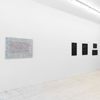Sight Unseen Click on images to view project. |
 |
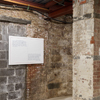 |
|||||||
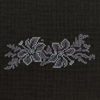 |
 |
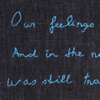 |
 |
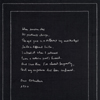 |
||||
 |
 |
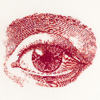 |
 |
 |
||||
Sight Unseen, 2019 [From the press release] Situated at the alleged end of the Gutenberg age, when digital technologies strive to replace paper with glowing screens, Sight Unseen considers the physical manifestations of writing and the persistence of analog productions of language. In thirty embroideries, made over the past three years, Reichek excerpts a wide range of texts to explore how invisible thoughts become materialized, and how past events are threaded into and through the present. In Sight Unseen, Reichek complicates and encumbers language-generating practices that are otherwise quickly accomplished. With needle and thread she painstakingly renders a broad range of fonts, scripts, and scrawls, thereby slowing the hand’s fluidity and extending writing’s manual labor, even as the resulting illusion conceals the process by which it was made. As with all of her embroideries that feature language, the texts in these works are physically attached to and pulled through surfaces of woven linen. For Reichek, embroidering words onto fabric rejoins text to its etymological sibling, textile. Many of the embroideries here deal with handwriting techniques, ranging from the old-fashioned Palmer method of cursive writing, to digital fonts that imitate cursive script, to samples of actual handwriting that Reichek solicited from family members, friends, and artist colleagues. Two works in this vein remake prized autograph manuscripts from English literature entirely in thread—William Blake’s illuminated poem “The Sick Rose,” and Samuel Taylor Coleridge’s 1797 Crewe Manuscript draft of “Kublai Khan.” Other pieces reproduce a variety of both serif and sans-serif typefaces, recalling the handmade origins of contemporary digital typography. Sight Unseen also reflects on the material history of paper, as Reichek’s needle reproduces graphic conventions such as the ruled lines of notebook sheets, or the page layouts of mass-marketed books. In The Purloined Letter (2017), a folded piece of white linen restages the titular object of Edgar Allen Poe’s 1844 detective story, while Faust and Mephisto (2016) reformats a dialogue from Goethe’s play into an ornately scripted contract authenticating the sale of Faust’s soul. The texts assembled for Sight Unseen address ideas of legibility and concealment, the hidden nature of the self, the legacy of political and social forces, and the invisible realm of dreams, ambitions, and fantasies. Six embroideries from 2018–19 compile a suite of poems by Anna Akhmatova, which explore the trauma of exile and disappearance and hint darkly at parallels in Russia today. However, invisibility for Reichek is not necessarily bad—it may even be desirable, especially in our time of maximum public display and digital visibility. It can be “a source of both terror and comfort,” as Marilynne Robinson writes in Minimally Existent (2016)—or a retreat into “being oneself” as Virginia Woolf puts it in For Now (To the Lighthouse) (2016). In Absence (2016), Elena Ferrante sees “the structural absence of the author” as “a creative space . . . full of possibilities.” By frustrating the inscription and transmission of language, Reichek hopes to create a quiet liminal space for looking, reading, and contemplation. Sight Unseen is Reichek’s solo continuation of a collaborative project with the sculptor Jeanne Silverthorne, entitled Invisible Citings, which was first shown at The Addison Gallery of American Art at Phillips Academy in 2017.
|


